GA4 Bounce Rate vs. UA: What’s the Difference?
When GA4 was first launched it did not include a bounce rate metric. That changed on July 11, 2022 when bounce rate was added to GA4. But it’s a different metric and calculation from what we were used to.
Let’s dig in to all things bounce rate related for Google Analytics.
What is Bounce Rate in Google Analytics 4?
Bounce rate in GA4 is simply the inverse of the GA4 engagement rate. So if the engagement rate over a given period of time is 35%, the bounce rate is 65% (100% – 35% = 65%).
If the engagement rate is 65%, then the bounce rate is 35%. The GA4 bounce rate is a derived via the engagement rate. Any of us who were familiar with Universal Analytics know this is quite different from the old calculation for bounce rate. In fact, many of the UA diehards might still not even understand the GA4 engagement rate. You can watch the embedded video below or keep on reading.
Let’s define engagement rate next. And you can check this out if you want a more comprehensive comparison of UA vs. GA4.
What is Engagement Rate in Google Analytics 4?
Engagement rate is a measure of how often an engaged session takes place during a given time frame. So if your site had 1,000 sessions last month and 562 were engaged sessions then your engagement rate would be 56.2% (562 / 1000 = 56.2%).
You can read Google’s perspective on engagement rate here.
What is an Engaged Session in GA4?
A engaged session is a session that lasts for 10 seconds (with the screen in view), or more or included at least 2 pageviews, or had at least 1 conversion event. This engagement metric in GA4 is new compared to Universal Analytics.
Where Can I Find Bounce Rate in GA4?
Bounce rate is not currently available within GA4 standard reports, but you can get to it by customizing a standard report or through the Explorations tab in GA4. If you want to see an example of the former, here’s how you can customize the Session Acquisition report to create a Campaign report for your UTM tagged traffic. To build an Exploration, hit the “Explore” tab in the left-hand navigation in GA4.
Then, hit the “Blank” template underneath the text that says “start a new exploration”.
Now, hit the plus sign next to “Metrics” as you can see below to add a metric to your report.
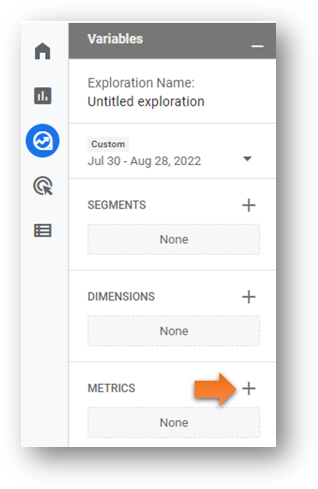
You’ll now be able to search through the available metrics. Search for bounce rate using the search bar. Hit the check mark next to the metric and then hit the blue “Import” button to add it to your report.

From there, you’ll want to add at least 1 dimension. For example, you could use “landing page” and then sort to see what landing pages have your highest and lowest bounce rates. Just keep in mind that this is a different calculation from Universal Analytics so you can’t really compare this to your historical UA data.
What is Bounce Rate in Universal Analytics (UA)?
A “bounce” in Universal Analytics is any single page session. It doesn’t matter if the actual time on page lasts for 1 second or 10 minutes. If there was only one page viewed it will count as a bounce. So if there were 1,000 hypothetical sessions and only 250 included multiple pageviews, that would work out to a bounce rate of 75% in UA.
There were ways to change the calculation for bounce rate in UA (for example, by setting certain events like scroll activity or file downloads to preclude a single page session from counting as a bounce), but that was not the default. It’s possible we’ll all end up liking the new GA4 bounce rate calculation more. For now, it’s a good idea to just know that it’s different.
Concluding Bounce Rate Thoughts
Personally. I’d argue that it’s not particularly helpful for GA4 bounce rate to exist when it has the same name but an entirely different calculation. Somehow, however, I didn’t get asked. ; )
If you’re interested in more GA4 resources, here a few of my recommendations. And you can click here to subscribe to the Root and Branch YouTube channel where this is typically a video a week on this kind of stuff.
- A running list of GA4 FAQ
- 6 Important Setup Tasks for GA4
- How to set up link click tracking in GA4 (vs. UA)
- How to set up page timer tracking in GA4
- Some GA4 Problems
- About segments in GA4 vs. UA
Wrapping Up
Thanks for reading all about GA4 bounce rate (or at least, what qualifies as GA4 bounce rate today!). Best of luck to you in all things GA4 and your digital marketing journey overall.

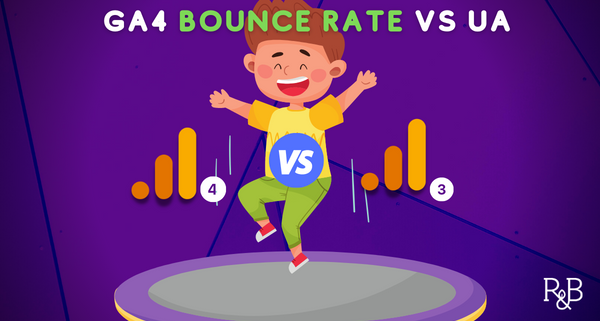
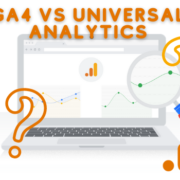
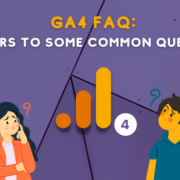
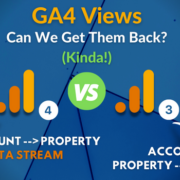
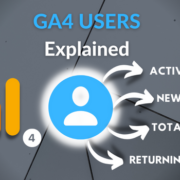

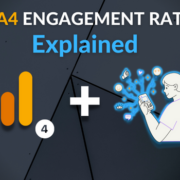


Trackbacks & Pingbacks
[…] Bounce rate in GA4 vs UA […]
[…] Bounce rate in GA4 vs UA […]
[…] Bounce rate in GA4 vs UA […]
[…] Bounce rate in GA4 vs UA […]
[…] Bounce rate in GA4 vs UA […]
[…] Bounce rate in GA4 vs UA […]
[…] Bounce rate in GA4 vs UA […]
[…] different calculation in GA4 as compared to bounce rate in UA. This is confusing. This comparison explains the difference so you know what you’re looking at in […]
[…] Bounce rate in GA4 vs UA […]
[…] Bounce rate in GA4 vs UA […]
[…] calculation and an altogether different metric than bounce rate in GA4. You can read about the different bounce rates here. You may decide that this new “bounce rate” is fine for your purposes. In that case, […]
[…] note: your engaged session timer will affect your GA4 bounce rate. That’s because bounce rate in GA4 is simply the inverse of the “engaged session rate.” As part of step #3, I’d […]
[…] Bounce rate in GA4 vs UA […]
[…] Bounce rate in GA4 vs UA […]
[…] new GA4 bounce rate will simply be the inverse of engagement rate. Here’s an explanation of bounce rate in GA4 vs. […]
Leave a Reply
Want to join the discussion?Feel free to contribute!